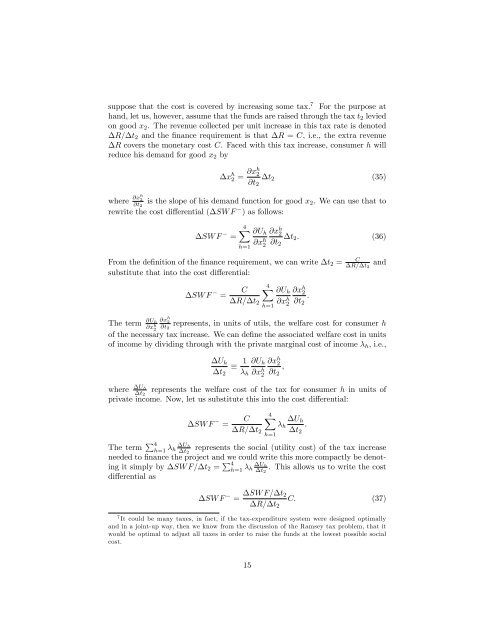Lecture Note 15: Social Cost Benefit Analysis - University of ...
Lecture Note 15: Social Cost Benefit Analysis - University of ...
Lecture Note 15: Social Cost Benefit Analysis - University of ...
Create successful ePaper yourself
Turn your PDF publications into a flip-book with our unique Google optimized e-Paper software.
suppose that the cost is covered by increasing some tax. 7 For the purpose at<br />
hand, let us, however, assume that the funds are raised through the tax t2 levied<br />
on good x2. The revenue collected per unit increase in this tax rate is denoted<br />
R= t2 and the …nance requirement is that R = C, i.e., the extra revenue<br />
R covers the monetary cost C. Faced with this tax increase, consumer h will<br />
reduce his demand for good x2 by<br />
x h 2 = @xh 2<br />
@t2<br />
t2<br />
(35)<br />
where @xh<br />
2<br />
@t2 is the slope <strong>of</strong> his demand function for good x2. We can use that to<br />
rewrite the cost di¤erential ( SW F ) as follows:<br />
SW F =<br />
4X<br />
h=1<br />
@Uh<br />
@xh @x<br />
2<br />
h 2<br />
@t2<br />
t2: (36)<br />
From the de…nition <strong>of</strong> the …nance requirement, we can write t2 = C<br />
R= t2 and<br />
substitute that into the cost di¤erential:<br />
The term @Uh<br />
@x h 2<br />
SW F =<br />
C<br />
4X<br />
@Uh<br />
R= t2 @x<br />
h=1<br />
h 2<br />
@x h 2<br />
:<br />
@t2<br />
@x h<br />
2 represents, in units <strong>of</strong> utils, the welfare cost for consumer h<br />
@t2<br />
<strong>of</strong> the necessary tax increase. We can de…ne the associated welfare cost in units<br />
<strong>of</strong> income by dividing through with the private marginal cost <strong>of</strong> income h, i.e.,<br />
Uh<br />
t2<br />
1<br />
h<br />
@Uh<br />
@x h 2<br />
@x h 2<br />
;<br />
@t2<br />
Uh where represents the welfare cost <strong>of</strong> the tax for consumer h in units <strong>of</strong><br />
t2<br />
private income. Now, let us substitute this into the cost di¤erential:<br />
SW F =<br />
C<br />
4X<br />
R= t2<br />
h=1<br />
The term P4 h=1 h Uh represents the social (utility cost) <strong>of</strong> the tax increase<br />
t2<br />
needed to …nance the project and we could write this more compactly be denoting<br />
it simply by SW F= t2 = P4 h=1 h Uh . This allows us to write the cost<br />
t2<br />
di¤erential as<br />
SW F =<br />
h<br />
Uh<br />
t2<br />
:<br />
SW F= t2<br />
C: (37)<br />
R= t2<br />
7 It could be many taxes, in fact, if the tax-expenditure system were designed optimally<br />
and in a joint-up way, then we know from the discussion <strong>of</strong> the Ramsey tax problem, that it<br />
would be optimal to adjust all taxes in order to raise the funds at the lowest possible social<br />
cost.<br />
<strong>15</strong>


